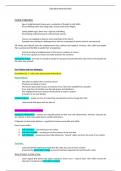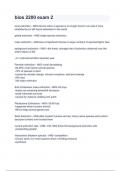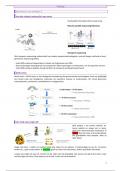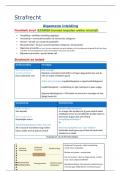MNO 3701 Production & Operations
Management
Chapter 13
Measuring and improving performance
All operations therefore need some kind of performance measurement as a prerequisite for improvement.
Performance measurement
Performance measurement is the process of quantifying action, where measurement means the process
of quantification and the performance of the operation is assumed to derive from actions taken by its
management.
Some kind of performance measurement is a prerequisite for judging whether an operation is good, bad
or indifferent. Without performance measurement, it would be impossible to exert any control over an
operation on an on-going basis. A performance measurement system that gives no help to on-going
improvement is only partially effective.
The five performance objectives which we have used throughout this book can be regarded as the
dimensions of overall performance that satisfy customers. The market's needs and expectations of each
performance objective will vary.
The extent to which an operation meets market requirements will also vary
Performance measurement, as we are treating it here, concerns three generic issues:
What factors to include as performance measures?
Which are the most important performance measures?
What detailed measures to use?
What factors to include as performance measures?
The five generic performance objectives - quality, speed, dependability, flexibility and cost - can be broken
down into more detailed measures, or they can be aggregated into 'composite' measures, such as
'customer satisfaction', 'overall service level' or 'operations agility'.
These composite measures may be further aggregated by using measures such as 'achieve market
objectives', 'achieve financial objectives', 'achieve operations objectives' even 'achieve overall strategic
objectives'.
1
,The more aggregated performance measures have greater strategic relevance insomuch as they help to
draw a picture of the overall performance of the business, although by doing so they necessarily include
many influences outside those that operations performance improvement would normally address.
The more detailed performance measures are usually monitored more closely and more often, and
although they provide a limited view of an operation's performance, they do provide a more descriptive
and complete picture of what should be and what is happening within the operation.
In practice, most organisations will choose to use performance targets from throughout the range
What are the most important performance measures?
A compromise is reached by making sure that there is a dear link between the operation's overall strategy,
the most important or 'key’ performance indicators (KPIs) that reflect strategic objectives, and the bundle
of detailed measures that are used to ‘flesh out each key performance indicator:
Obviously, unless strategy is well defined, it is difficult to ‘target’ a narrow range of key performance
indicators.
What detailed measures to use?
The five performance objectives - quality, speed, dependability, flexibility and cost - are really composites
of many smaller measures
All of these measures individually give a partial view of the operation’s cost performance and many of
them overlap In terms of the Information they include.
Each of them does give a perspective on the cost performance of an operation that could be useful either
to identify areas for improvement or to monitor the extent of improvement.
If an organisation regards its ‘cost’ performance as unsatisfactory, disaggregating It into ‘purchasing
efficiency’, ‘operations efficiency’, staff productivity’, etc. might explain the root cause of the poor
performance.
The balanced scorecard approach
'The balanced scorecard retains traditional financial measures.
Financial measures tell the story of past events, an adequate story for industrial age companies for which
investments in long-term capabilities are customer relationships were not critical for success.
2
, These financial measures are inadequate, however, for guiding and evaluating the journey that
information age companies must make to create future value through investment in customers, suppliers,
employees, processes, technology, and innovation.'
Generally operations performance measures have been broadening in their scope. It is now generally
accepted that the scope of measurement should, at some level, include external as well as internal, long-
term as well as short-term, and 'soft' as well as ‘hard’ measures.
The best- known manifestation of this trend is the balanced scorecard' approach
In the same way as traditional performance measurement systems, the balanced scorecard approach
attempts to provide the important information that is required to allow the overall strategy of an
organisation to be reflected adequately in specific performance measures.
It includes more operational measures of customer satisfaction, internal processes, innovation and other
improvement activities.
In doing so it measures the factors behind financial performance which are seen as the key drivers of
future financial success. In particular, it is argued that a balanced range of measures enables managers
to address the following questions:
• How do we look to our shareholders (financial perspective)?
• What must we excel at (internal process perspective)?
• How do our customers see us (the customer perspective)?
• How can we continue to improve and build capabilities (the learning and growth perspective)?
The balanced scorecard attempts to bring together the elements that reflect a business's strategic
position, including product or service quality measures, product and service development times, customer
complaints, labour productivity and so on. At the same time it attempts to avoid performance reporting
becoming unwieldy by restricting the number of measures and focusing especially on those seen to be
essential.
The advantages of the approach are that it presents an overall picture of the organisation's performance
in a single report, and by being comprehensive in the measures of performance it uses, encourages
companies to take decisions in the interests of the whole organisation rather than sub-optimising around
narrow measures.
Developing a balanced scorecard is a complex process and is now the subject of considerable debate.
One of the key questions that has to be considered is how specific measures of performance should be
designed. Inadequately designed performance measures can result in dysfunctional behaviour, so teams
of managers are often used to develop a scorecard which reflects their organisation's specific needs.
Setting target performance
3
Management
Chapter 13
Measuring and improving performance
All operations therefore need some kind of performance measurement as a prerequisite for improvement.
Performance measurement
Performance measurement is the process of quantifying action, where measurement means the process
of quantification and the performance of the operation is assumed to derive from actions taken by its
management.
Some kind of performance measurement is a prerequisite for judging whether an operation is good, bad
or indifferent. Without performance measurement, it would be impossible to exert any control over an
operation on an on-going basis. A performance measurement system that gives no help to on-going
improvement is only partially effective.
The five performance objectives which we have used throughout this book can be regarded as the
dimensions of overall performance that satisfy customers. The market's needs and expectations of each
performance objective will vary.
The extent to which an operation meets market requirements will also vary
Performance measurement, as we are treating it here, concerns three generic issues:
What factors to include as performance measures?
Which are the most important performance measures?
What detailed measures to use?
What factors to include as performance measures?
The five generic performance objectives - quality, speed, dependability, flexibility and cost - can be broken
down into more detailed measures, or they can be aggregated into 'composite' measures, such as
'customer satisfaction', 'overall service level' or 'operations agility'.
These composite measures may be further aggregated by using measures such as 'achieve market
objectives', 'achieve financial objectives', 'achieve operations objectives' even 'achieve overall strategic
objectives'.
1
,The more aggregated performance measures have greater strategic relevance insomuch as they help to
draw a picture of the overall performance of the business, although by doing so they necessarily include
many influences outside those that operations performance improvement would normally address.
The more detailed performance measures are usually monitored more closely and more often, and
although they provide a limited view of an operation's performance, they do provide a more descriptive
and complete picture of what should be and what is happening within the operation.
In practice, most organisations will choose to use performance targets from throughout the range
What are the most important performance measures?
A compromise is reached by making sure that there is a dear link between the operation's overall strategy,
the most important or 'key’ performance indicators (KPIs) that reflect strategic objectives, and the bundle
of detailed measures that are used to ‘flesh out each key performance indicator:
Obviously, unless strategy is well defined, it is difficult to ‘target’ a narrow range of key performance
indicators.
What detailed measures to use?
The five performance objectives - quality, speed, dependability, flexibility and cost - are really composites
of many smaller measures
All of these measures individually give a partial view of the operation’s cost performance and many of
them overlap In terms of the Information they include.
Each of them does give a perspective on the cost performance of an operation that could be useful either
to identify areas for improvement or to monitor the extent of improvement.
If an organisation regards its ‘cost’ performance as unsatisfactory, disaggregating It into ‘purchasing
efficiency’, ‘operations efficiency’, staff productivity’, etc. might explain the root cause of the poor
performance.
The balanced scorecard approach
'The balanced scorecard retains traditional financial measures.
Financial measures tell the story of past events, an adequate story for industrial age companies for which
investments in long-term capabilities are customer relationships were not critical for success.
2
, These financial measures are inadequate, however, for guiding and evaluating the journey that
information age companies must make to create future value through investment in customers, suppliers,
employees, processes, technology, and innovation.'
Generally operations performance measures have been broadening in their scope. It is now generally
accepted that the scope of measurement should, at some level, include external as well as internal, long-
term as well as short-term, and 'soft' as well as ‘hard’ measures.
The best- known manifestation of this trend is the balanced scorecard' approach
In the same way as traditional performance measurement systems, the balanced scorecard approach
attempts to provide the important information that is required to allow the overall strategy of an
organisation to be reflected adequately in specific performance measures.
It includes more operational measures of customer satisfaction, internal processes, innovation and other
improvement activities.
In doing so it measures the factors behind financial performance which are seen as the key drivers of
future financial success. In particular, it is argued that a balanced range of measures enables managers
to address the following questions:
• How do we look to our shareholders (financial perspective)?
• What must we excel at (internal process perspective)?
• How do our customers see us (the customer perspective)?
• How can we continue to improve and build capabilities (the learning and growth perspective)?
The balanced scorecard attempts to bring together the elements that reflect a business's strategic
position, including product or service quality measures, product and service development times, customer
complaints, labour productivity and so on. At the same time it attempts to avoid performance reporting
becoming unwieldy by restricting the number of measures and focusing especially on those seen to be
essential.
The advantages of the approach are that it presents an overall picture of the organisation's performance
in a single report, and by being comprehensive in the measures of performance it uses, encourages
companies to take decisions in the interests of the whole organisation rather than sub-optimising around
narrow measures.
Developing a balanced scorecard is a complex process and is now the subject of considerable debate.
One of the key questions that has to be considered is how specific measures of performance should be
designed. Inadequately designed performance measures can result in dysfunctional behaviour, so teams
of managers are often used to develop a scorecard which reflects their organisation's specific needs.
Setting target performance
3











